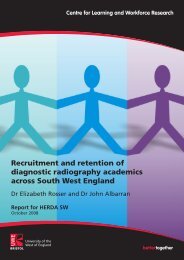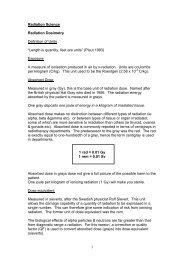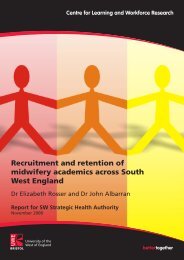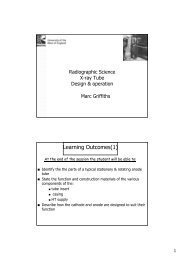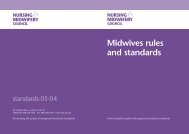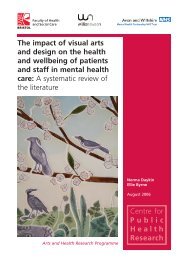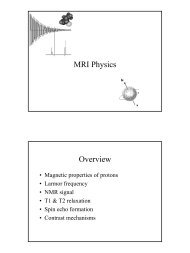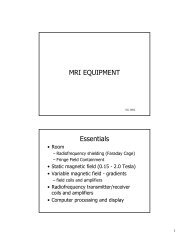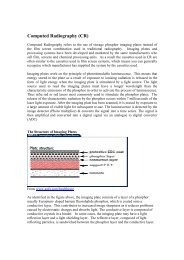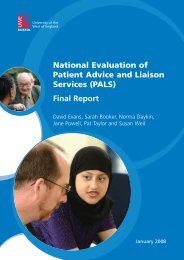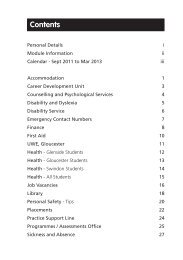The impact of arts on health and wellbeing of young people: a ...
The impact of arts on health and wellbeing of young people: a ...
The impact of arts on health and wellbeing of young people: a ...
Create successful ePaper yourself
Turn your PDF publications into a flip-book with our unique Google optimized e-Paper software.
4. Results <str<strong>on</strong>g>of</str<strong>on</strong>g> the Quantitative Studies<br />
<str<strong>on</strong>g>The</str<strong>on</strong>g> quantitative studies identified a range <str<strong>on</strong>g>of</str<strong>on</strong>g> benefits <str<strong>on</strong>g>of</str<strong>on</strong>g> drama <strong>and</strong><br />
performing <str<strong>on</strong>g>arts</str<strong>on</strong>g> in three main areas: peer interacti<strong>on</strong> <strong>and</strong> social skills; sexual<br />
<strong>health</strong> <strong>and</strong> HIV/AIDS knowledge, attitudes <strong>and</strong> risk. A number <str<strong>on</strong>g>of</str<strong>on</strong>g> positive<br />
benefits <str<strong>on</strong>g>of</str<strong>on</strong>g> performing <str<strong>on</strong>g>arts</str<strong>on</strong>g> were identified including changes in self c<strong>on</strong>cept,<br />
self esteem, knowledge, peer <strong>and</strong> social interacti<strong>on</strong>, attitudes <strong>and</strong> behaviour.<br />
4.1 Peer interacti<strong>on</strong> <strong>and</strong> social skills<br />
Two studies focused <strong>on</strong> general <strong>health</strong>, educati<strong>on</strong>al <strong>and</strong> social benefits <str<strong>on</strong>g>of</str<strong>on</strong>g><br />
drama with <strong>young</strong> <strong>people</strong>. McArdle et al. (2002) carried out a r<strong>and</strong>omised<br />
c<strong>on</strong>trol trial <str<strong>on</strong>g>of</str<strong>on</strong>g> 122 children aged 11 in a deprived area <str<strong>on</strong>g>of</str<strong>on</strong>g> the UK. <str<strong>on</strong>g>The</str<strong>on</strong>g><br />
children were identified as ‘at risk’ according to criteria developed in<br />
c<strong>on</strong>sultati<strong>on</strong> with teachers. <str<strong>on</strong>g>The</str<strong>on</strong>g>se included scholastic under performance,<br />
known major family problems, ill nourished or poorly cared for appearance,<br />
impaired peer relati<strong>on</strong>ships <strong>and</strong> behavioural <strong>and</strong> emoti<strong>on</strong>al difficulties.<br />
<str<strong>on</strong>g>The</str<strong>on</strong>g> interventi<strong>on</strong> was a <strong>on</strong>e-hour group drama sessi<strong>on</strong> lasting 12 weeks <strong>and</strong><br />
the c<strong>on</strong>trol group worked <strong>on</strong> nati<strong>on</strong>al curriculum maths <strong>and</strong> English. Initially<br />
there was r<strong>and</strong>om allocati<strong>on</strong> with some attempt at blinding, with participants<br />
allocated to interventi<strong>on</strong> <strong>and</strong> c<strong>on</strong>trol groups by members <str<strong>on</strong>g>of</str<strong>on</strong>g> the research team<br />
who did not know them. However, the authors report that afterwards some<br />
children were exchanged between groups following c<strong>on</strong>sultati<strong>on</strong> with teachers<br />
in order to ensure an appropriate case mix for the groups. Seventeen <str<strong>on</strong>g>of</str<strong>on</strong>g> the<br />
original participants were not included in the follow-up.<br />
Issues <str<strong>on</strong>g>of</str<strong>on</strong>g> sample size <strong>and</strong> power c<strong>on</strong>siderati<strong>on</strong>s were addressed based <strong>on</strong> a<br />
previous study that dem<strong>on</strong>strated significant differences between<br />
interventi<strong>on</strong>s each comprising approximately 60 children (Kolvin et al., 1981).<br />
Hence, in McArdle et al.’s 2002 study 122 children were r<strong>and</strong>omised between<br />
the group therapy <strong>and</strong> the curriculum studies interventi<strong>on</strong>s, which ran in<br />
parallel, eight children in each group, repeated in three c<strong>on</strong>secutive terms in<br />
two schools.<br />
Measurements encompassed three domains: behaviour, symptoms <strong>and</strong> self<br />
c<strong>on</strong>cept. Established measurements were used including the Teacher Report<br />
Form (TRF), the Youth Self Report tool (YSR), the Multidimensi<strong>on</strong>al Self<br />
C<strong>on</strong>cept Scale (MSCS) <strong>and</strong> the parent completed Child Behaviour Checklist<br />
(CBCL). A series <str<strong>on</strong>g>of</str<strong>on</strong>g> analyses were reported including use <str<strong>on</strong>g>of</str<strong>on</strong>g> an Intercooled<br />
STATA 6.0 for Windows r<strong>and</strong>om effects regressi<strong>on</strong> model technique that<br />
allowed for both within <strong>and</strong> between subject effects to be c<strong>on</strong>sidered as well<br />
as changes over time.<br />
<str<strong>on</strong>g>The</str<strong>on</strong>g> study found significant decline in self reported symptoms <strong>and</strong> significant<br />
improvements in self c<strong>on</strong>cept as well as teacher assessed behaviour am<strong>on</strong>g<br />
the interventi<strong>on</strong> drama group compared with the curriculum studies group.<br />
<str<strong>on</strong>g>The</str<strong>on</strong>g> study also found evidence <str<strong>on</strong>g>of</str<strong>on</strong>g> short-term improvements in behaviour<br />
assessed by parents, although these improvements were not sustained at<br />
follow-up (McArdle et al., 2002). <str<strong>on</strong>g>The</str<strong>on</strong>g> authors c<strong>on</strong>cluded that group therapy<br />
11



